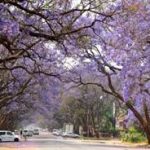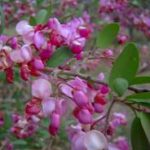TREE LIFE
October 2016
MASHONALAND CALENDAR
Saturday 1st October: Botanic Garden Walk. Meet in the car park at 0845 for 0900 hours. It might by hot but this is an exciting time of year botanically, so don’t miss out.
Sunday October 16th : The Ornithological Reserve at Lake Chivero (PLEASE NOTE THIS IS NOT KUIMBA SHIRI SANCTUARY). Please also note that this is quite a tricky venue to get to with many twists and turns so we will meet at Prince Edward Car Park at 0830 hours for a 0845 hour take off. If you are familiar with that area and know how to get there please contact our Chairman, Tony Alegria, to find out where to meet up with the convoy. We visited this venue a while back and it proved interesting, with additional good bird viewing along the lake shore.
Saturday October 22nd : Return visit to the Mukuvisi Woodlands. Meet at 1415 for a 1430 start at the Mukuvisi car park where we hope to do an Acacia trail, followed by a short report back from our recent expedition to Humani Ranch when we also hope to share various videos and photographs of what we saw and did. The film show will be in the Rondavel at the Mukuvisi.
Advance notice of the November 20th, 2016 meeting. We will be visiting Imire Park at Hwedza again. We will be exploring the trees around Castle Kopje and along the adjacent stream that feeds into the dam, which should be interesting, especially if they have had some rain. Imire has agreed to waive the $10 p/p entrance fee for the day and are offering us a famous Sable Lodge lunch at the dam picnic site for $15 p/p. We are hoping that either Reily Travers or Judy Travers will give us a short resume of their community outreach programme in the area. Please keep this date diarised, you will need to confirm your place(s) before the 10th November. More on this in the November Newsletter
OBITUARY
It was with sadness that the Tree Society learnt of the passing of Fr. Hugh Ross in Preston, England in early August 2016, at the age of 96. Fr. Ross was the inspiration behind the beautiful garden at St Georges College that the Tree Society has visited on several occasions.

Photo courtesy of OG Gregg Robinson, Oct 2007
Fr Ross began teaching at St Georges in 1955 and was a stalwart maths teacher, who also taught cricket and, later, swimming. He was very well-known and admired by many generations of OGs. He left the College in 2007 to return to Preston in the UK. A funeral for Fr Ross was held in Preston, England followed by a memorial service and tea at St Georges Chapel so that all Old Georgians, past parents and current and past staff could pay their respects. May Fr Ross’ soul rest in peace.
– Ed
PLANTED TREES OF HARARE Tecoma stans
Family – Bignoniaceae
Synonyms – Bignonia stans & Stenolobium stans. Common name – although there are many common names for this tree – we call it Yellow Bells. There are other Tecoma species grown in Zimbabwe which have orange bells – see photo of Tecoma alata.
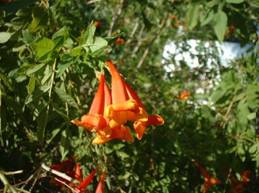
Tecoma alata flowers
Tecoma stans is native to southern United States, Mexico, the Caribbean, Peru and Ecuador and is now cultivated in many parts of the world. In some areas it has become invasive and considered to be a weed. It is either a large shrub or a much branched tree which can grow up to 10 metres in height, but generally less than that in Zimbabwe. Here it is grown as a street tree but also grown in gardens as an ornamental tree or occasionally as a hedge.
The bark is light brown to pale grey in colour, furrowed, and relatively rough in texture. The compound leaves (10-25 cm long) are opposite and are borne on slender stalks 1-9 cm long. They may have three to 13 leaflets, but usually have three to seven. The leaflets are narrowly egg-shaped in outline with the broad end at base or elongated in shape (25-100 mm long and 8-30 mm wide) and have a pointed tip. Their margins are serrated and they are mostly hairless, though a few hairs may be present on their undersides near the midrib.
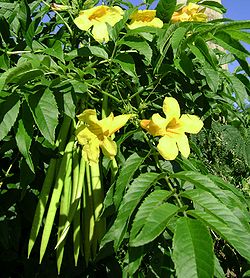
Tecoma stans flowers
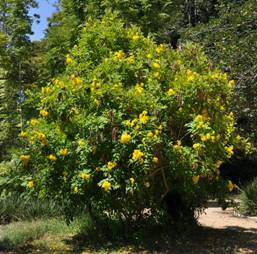
Tecoma stans tree
The showy flowers are borne in several-flowered clusters (5-15 cm long) that are first produced at the ends of the branches, and then later in the leaf forks near the tips of the branches. These flowers are bright yellow in colour, tubular shape, and borne on short stalks. The flower tube has five rounded
lobes and has several faint reddish lines in the throat which act as nectar guides to pollinators. Flowering may occur throughout the year.
The fruit is a long flat pod which has seeds that have a single small papery wing. These fruit turn from green to brown in colour as they mature and finally split open to release the numerous seeds. Hence its weedy status in some countries. Tecoma stans has medicinal applications.
Sources :
BioNET-EAFRINET – Invasive Plants and Fact Sheets.
https://giasipartnership.myspecies.info/en/content/bionet-eafrinet-invasive-plants-keys-and-fact-sheets
Navie, S. and Adkins, A. 2008. Environmental Weeds of Australia. Centre for Biological Information Technology, University of Queensland, Brisbane.
Photos from Wikipedia, www.wikipedia.com/tecoma; Urban Forest Ecosystems Institute: Tecoma stans https://selectree.calpoly.edu/tree-detail/tecoma-stans; www.tecoma.alata.com
– Tony Alegria
Ed’s note:
Tecoma capensis (Cape Honeysuckle from the Eastern Cape in South Africa, Swaziland and southern Mozambique, sometimes also called Tecomaria capensis) is another species of Tecoma that is widely grown in Harare and which flowers in a variety of oranges, yellows and apricots.
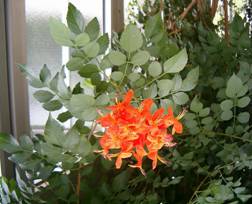
Tecoma capensis Photo: Bart Wursten, Flora of Zimbabwe.
Tecoma capensis is an excellent plant to use in a wildlife garden in southern Africa, since it is popular with sunbirds and certain insects due to its nectar. As a scrambler, it can be quite dense when pruned and makes a good nesting site for birds. The larvae of the Death’s Head Hawkmoth (Acherontia atropos) and the Fulvous Hawkmoth (Ceolonia mauritii) eat the leaves of this plant.
Tecoma is a genus of 14 species of shrubs or small trees. Twelve species are from the Americas, while the other two species are African. The generic name is derived from the Aztec word tecoma xochitl, which was applied by the indigenous peoples of Mexico to plants with tubular flowers.
Sources:
Wikipedia: Tecoma capensis. https://en.wikipedia.org/wiki/Tecoma_capensis
OUTING TO HUMANI RANCH, SAVE CONSERVANCY
16th – 20th September 2016 DAY ONE
In January 2016 when discussing a “long outing” for the Society for this year, I ran past the Committee a visit to Humani Ranch – having visited the Ranch twice before I knew that it would be an exciting venue. The idea was met with lukewarm enthusiasm and I was asked to inquire into the possibilities.
Then came the negotiations for a time slot for the expedition. This was not easy as it had to fit into the hunting operations on the Ranch, and depended on the availability of our specialists, Mark Hyde and Meg Coates Palgrave. September was agreed upon, deposit paid, etc. etc.
All was going well until some Spanish hunters decided that the time in September booked by us was going to suit them best. Lots of anxieties and negotiations followed, but what I have to say is that the management and staff at Humani pulled out all the stops for us and I think that everyone was reasonably happy about their accommodation and all the other details of the trip.
I went down the day before the main party with my stalwart and long suffering travelling companions, Graham and Bilal, and just as well we did as there was much to resolve, like fridge/freezer space, no Zesa at the camp, for a while there was no water and it was 38 degrees! Not only that, camp coordinator Adrienne, who had been in Harare and who was returning with a truck load of vitals for our visit, was involved in a road traffic accident on Thursday morning and our groceries were scattered across the street – this was pretty anxious-making with fifteen people with high expectations arriving the following day! By Friday morning all was in order and I decided to drive with our professional hunter guide, Lymon, to the Save River to check the next day’s outing before the rest of the participants arrived. What a super morning we had. Here I must add that Lymon proved a Godsend to the whole experience. His quiet, knowledgeable and very professional approach to treeing, tracking and dealing with an exciting interlude with elephant was so appreciated by us all.
On Friday participants filtered in during the day and were shown where they were billeted, before returning to the main camp for happy hour and supper. The two camp attendants, Enos and Lucia were amazing and attended to our every need – iced water, boiling water and camp fires but, most of all, outstanding meals cooked under the most primitive conditions – the tented camp where we were is not finished yet but more than adequate. The supper of game potjie and sadza was memorable.
The activities of the three days we had there will be written up by John Meikle, Tempe van der Ruit and Karl van Laeren in due course. Mark Hyde will let us have a copy of all the trees/shrubs seen on the trip.
And now, having been home for a few days, unpacked and recovered – or nearly recovered – I look back and am so grateful for the camaraderie, companionship and fun we all experienced, and on top of all of that, a most exciting and successful botanising expedition. It was definitely worth all the anxiety and sweat and tears that went into the organising of the trip.
Huge thanks go to Roger, Ann and Adrienne for pulling out all the stops and most of all to Lymon for guarding, guiding and sharing his knowledge with us.
I might even muster up the energy to organise another longer outing next year.
– Mary Lovemore
DAY TWO
I am sure many of us who turned off the main road on a hot September day, while driving through a sea of bare trees and sticks only relieved by an occasional baobab or riverine vegetation, thought how any of us would make sense of it all. It was an interesting exercise in forensic botany – trunk characteristics, a dead leaf or a fallen pod.
Starting out on our bright and sunny second day, my first mistake was to assume from its whitish trunk that the tree in full flower in the middle of the camp was a Boscia, showing that first impressions are often wrong.
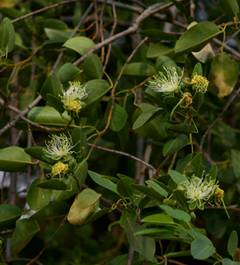
Maerua angolensis
In fact it was Maerua angolensis, the Bead-Bean, with a mass of creamy to yellow flowers. It belongs to the family Capparaceae (the Caper family) which was well represented at Humani. The common characteristics of this family are conspicuous flowers with long powder puff stamens and an ovary on a distinctive long stalk; leaves usually alternate which may be in tight clusters. Another member was M. edulis, the Blue-leaved Spider Bush, a small shrub with conspicuous bluish leaves that is apparently not browsed.
Capparis tomentosa, the Woolly Caper-Bush is a scrambling shrub with paired hooked spines at the base of the petiole, velvety leaves and white flowers with the usual prominent stamens. Thilachium africanum, the Cucumber Bush has simple or trifoliate leathery leaves, with a few terminal or axillary long-stamened flowers. Finally in this family, seen later in the day which was a highlight for Meg, was Boscia foetida subspecies rehmanniana with small leaves in clusters on angled dwarf spur branches. The bark is usually brown as opposed to the obviously white bark of B. albitrunca, the Shepherds Tree (Meg says the common name was coined in the Kalahari where shade is scarce, so hardly appropriate here).
At first sight, our stop on a rocky hillside seemed unpromising, but still yielded 25 identifications from the experts, with precious few leaves to work with. The most interesting was Gyrocarpus americanus, the Propeller Tree, the only representative of the Hernandiaceae family in southern Africa. Without the lobed leaves to see, the diagnostic feature is the fruit – a nut with two long, thin wings which spin like a helicopter when falling to the ground. There was also Sterculia rogersii, the Star Chestnut with grey bark pealing to reveal pink, purplish or creamy patches and the Lowveld Iron Plum Drypetes mossambicensis, which was last seen by me at Catapu in Mozambique and has alternate shiny bluish leaves (when it has them!).
On our journey down to the river, we passed through what must have been old cotton fields, because it was dominated by Vachellia (Acacia) tortilis, the Umbrella Thorn. This species had been badly damaged by elephants. Roger Whittall said some of the elephants were in need of translocation because their introduction has led to an over-population. This of course led to heated discussion on the merits and demerits of the new Acacia names, with Meg saying the taxonomists hadn’t gone far enough and David Hartung saying it was a very retrograde step! [The herbarium at Kew still uses Acacia – Ed.]
The difference, the fundis say, is that the African Acacia subgenus Aculeiferum, with 26 pairs of chromosomes (take their word for it), scattered thorns either in pairs or in threes, and spicate or capitate inflorescences, are allocated to the genus Senegalensis. On the other hand those allocated to genus Vachellia have 52 pairs of chromosomes, paired straight thorns, white or yellow flowers, and seeds either in one or two to three rows. That is whether we like it or not, we can blame the Australians for high-jacking the name Acacia for themselves!
The last stop of the day was for lunch on the banks of the Save River in the riverine forest. Forests are my passion and I must confess to having little enthusiasm for leafless trees and shrubs! It had been a very hot and tiring morning, especially as the cognoscenti insisted on stopping in the blazing heat with no shade while hot on the trail of an interesting leafless shrub. Here it was cool and shady as our picnic table was under a large Xeroderris stuhlmannii, the Wing Pod of the Papilionoideae sub-family whose pods are distinctly flattened with a prominent rim around the edge and can be held on the tree for a year. Also in the same family Xanthocercis zambesiaca, the Nyala Berry, is best for a campsite as it never loses its leaves. Combretum imberbe, the Leadwood, was also there, unfortunately this species has been over-exploited in Mozambique for Far East markets.
In the shrub layer was Manilkara mochisia the Lowveld Milkberry, family Sapotaceae, with simple alternate leaves and milky sap. Dalbergia arbutifolia, the Eastern Climbing Flatbean, is a small shrub or tree with four to seven pairs of opposite or sub-opposite leaflets, last seen on the Tree Society outing to New Years’ Gift.
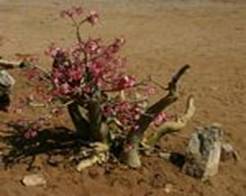
Sabi Star Photos: Bart Wursten, Flora of Zimbabwe
With temperatures reaching 36C, lunch was a leisurely affair in the shade, consisting of cold meat and salads. Some had a beer (me) and some had a snooze, happy in the knowledge that our PH Lymon was watching our backs for large beasts (with which we had an adrenaline rush a few days later!). And how (until now) could I have omitted the glorious Sabi Star Adenium multiflorum in full flower and truly spectacular in a landscape of dry bush waiting to burst into life?
But then I have a grand-daughter in York named by her homesick mother Arabella Sabi.
– JOHN MEIKLE
TO BE CONTINUED …….
The following slightly edited article and additional note were taken from Tree Life 31: September 1982. In view of the recent focus by forward-thinking staff of Curverid, an international tobacco company, on the importance of including the regeneration of miombo species in Zimbabwe in the push to provide sufficient biomass for continued small-scale Virgina tobacco production in the country (and the fact that work has been done on regeneration of miombo in more recent years) I thought it was particularly relevant. – Ed
THE IMPORTANCE OF REGROWTH
In 1974 we observed the international year of the tree and many Eucalyptus seedlings were planted in the communal lands. Since December 1980, in accordance with the expressed wish of the Prime Minister, the Tree Society has joined in the annual tree planting ceremonies. During the last few years we have been associated with indigenous and exotic tree planting all over the country. We have also been involved in a number of exercises aimed at encouraging natural regeneration on indigenous species and the results of these are available for anybody to see if they are interested. The positive conclusion is that, whilst planting is important, so also is natural regeneration and we believe that our small experiments conclusively show that regeneration need not be as slow as is sometimes believed.
In any planned land management for our communal areas, exotic plantations, which are relatively labour intensive all year round, can only cover a small percentage of available land. In an average communal area in the medium to high rainfall part of the country, after subtracting arable and better quality grazing land, an approximation of the amount of the wooded rough grazing land comes out at about between 40% and 60%. It is from this area that the people collect most of their fuelwood and building materials, together with those important items of small-scale farmers’ economy: fruit, medicine, small game, honey, bark fibre etc., which are not usually available in the exotic woodlots. In areas of poorer than average soil and climatic conditions and in particular where planted trees cannot not be watered, protection of the regeneration provides key resources.
Natural regrowth is a subject on which I have been unable to find any expert advice in the form of written literature. The ancient wisdom found widely where tradition still is strong, whereby trees harvested for fuel or poles are cut off at about waist height, is not the idleness I have sometimes heard it labelled. This custom ensures that the re-generation would get away quickly and get above the dangers of fire, frost and browse in the first season. [And this was confirmed in the early 90s by experimental evidence – Ed.) In many densely populated communal lands demand is such that this ancient wisdom is no longer followed. The result of clear felling down to ground level, where the first season’s regrowth is neither as strong nor fully protected from danger, can be seen in the deforested areas which one does not have to travel far from the capital to find.
Planned regeneration is in fact easy and much less labour is involved than in establishing exotic plantations. True, the yield of timber acre by acre will be much less, but the overall yield, when one takes into account all the other benefits detailed previously, will be much larger.
What I should like to see, wherever possible, is that Tree Society members and others interested, anyone who controls a chunk of ground – unused or waste, call it what you will – make a programme to first look for natural regeneration and then protect it from fire and trampling. The resultant speed at which growth takes place will be quite startling. The piece of waste ground concerned can be an odd corner of only a few square metres in factory grounds or garden, or larger areas such as the perimeter of school grounds, road verges and unused public land.
This is an appeal to anyone concerned with planning the coming December National Tree Day to publicise the aspect of regeneration as an extension of very essential “planting” – I believe they will be serving an extremely important need.
– George Hall
I have always thoroughly endorsed all George has said in connection with regeneration. The perfect example of the result of protection from chopping and fire is at the Arboretum at Lake McIlwaine [now Lake Chivero – Ed]. About 20 years ago the vegetation was but scrub, waist high, now on the lower slopes where there has been selective clearing the trees are huge and the area park-like. Higher up the hill, where the trees have merely been allowed to “do their own thing” there is no longer a view of the lake and the trees form a canopy 6 – 10m up, although they are rather close together and their trunks rather spindly.
– Meg Coates Palgrave
MEANINGS OF SCIENTIFIC BOTANICAL NAMES
I should like to start this time with a couple of quotations from my recently acquired 2008 edition of William T. Stearn’s BOTANICAL LATIN, very kindly sent to me from America by my cousin Dr Kathleen Coleman, James Loeb Professor of Classics at Harvard University. Under the section on Pronunciation it more or less paraphrases what I have been saying to people for a long time :
“Botanical Latin is essentially a written language, but the scientific names of plants often occur in speech. How they are pronounced really matters little provided they sound pleasant and are understood by all concerned. This is most likely to be attained by pronouncing them in accordance with the rules of classical Latin pronunciation.”
“ . . . . people tend to pronounce Latin words by analogy with words of their own language. Erasmus in 1528 published his ‘De recta Latini Graecique Sermonis Pronunciatione’ [Concerning the correct Pronunciation of Latin & Greek Speech] in which he described how a French ambassador at the court of the Emperor Maximilian made a speech in Latin ‘with so Gallic an accent that the Italians present thought he were speaking French’; a German, called upon to reply, sounded as if he were speaking German; . . .etc.”
So no-one need worry unduly about pronunciation!
Chrysophyllum viridifolium [KRISS OH FILL OOM VIH RID EE FOE LEE OOM]. Fluted Milkwood, SAPOTACEAE (MILKWOOD FAMILY)
Chrusos {χρυσος} = Gold; phullon (ϕυλλον) = leaf; viridis = green; folium = leaf.
So this plant is apparently a golden-leaf green-leaf! The genus is in Latinised Greek and the species is pure Latin, in which the word ‘folium’ is derived from phullon. Note that the two letters ‘y’ in Chrysophyllum were both ‘u’s’ in Greek and should therefore sound the same, as ‘i’ in ‘miss’ or as the sharp ‘u’ in French. The full name is descriptive of the rich green leaf with its covering of reddish-gold hairs on the underside.
Phyllanthus inflatus [FILL ANN THOOSS INN FLAH TOOSS]. Balloon-fruit Potato-bush, Family EUPHORBIACEAE
Phullon {ϕυλλον} = Leaf; anthos {ανθος} = flower; inflatus = inflated or swollen.
Some species in this genus have flattened leaf-like stems with flowers growing along their edges, while many have the inflorescences in the axils of the leaves, hence ‘Leaf-flower’; ‘inflatus’ is self-explanatory, referring to the balloon-like fruit.
Allophylus africanus [AL OH FIGH LOOSS AFF RICK AH NOOSS]
African False-rhus, Family SAPINDACEAE (LITCHI & SOAPBERRY FAMILY)
Allos {Αλλος} = Another, Different; phulé {ϕυλη} = race or tribe; phulia {ϕυλια} = wild olive; africanus = African.
The specific name is self-explanatory, but the generic is rather odd and I suspect should have been spelled Allophyllus [AL OH FILL OOSS] (a genus described by Linnaeus), meaning different-leaf; the two words ‘phulé’ & ‘phulia’ shown above do not seem to have any obvious connection with the plant, but I stand to be corrected.
– Dave Hartung
TONY ALEGRIA CHAIRMAN


